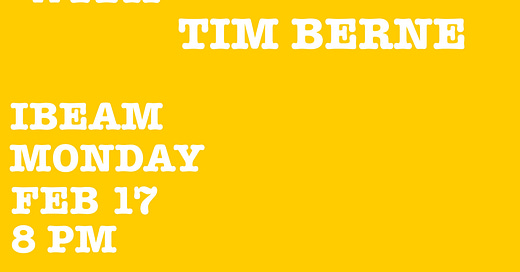The news is bad, the world is in flames. And yet, and yet.
The monthly series at Ibeam in Brooklyn continues tomorrow, Monday, February 17th, when Ember meets up with Mr. Tim Berne, the epitome of independence and commitment.
Tim came to the music primarily through saxophonist Julius Hemphill, a still under-recognized giant. Thanks to Mr. Berne’s undying commitment— he’s been composing his own music, forming bands, self-releasing albums, and booking his own tours for nearly 50 years!— he helps connect my generation to another era, an era no less fraught than our own, and to giants like Julius Hemphill, who did what needed to be done.
We owe Tim Berne, his cohort, and their forebears— Julius Hemphill, Phillip Wilson, the Art Ensemble of Chicago, and so many more— simply everything. If you’re in town, come join us.
When I read Robert Palmer’s Deep Blues (1981), his wonderful overview of how the Delta-based solo performer tradition worked its way into the broader pop mainstream, I wondered how that music struck the fierce intellects and advanced ears of Thelonious Monk, Dizzy Gillespie (both born 1917), Kenny Clarke (born 1914), and all the folks who gave rise to bebop. After all, Blind Lemon Jefferson, for example, was a famous recording artist (by the standards of the time) in 1926 and 1927, when Kenny Clarke was 12 and 13 years old. Clarke must have known the tradition, if not the exact records and performers.
And here’s Lewis Porter giving us the briefest glimpse of this tradition in Thelonious Monk’s early musical life. A brief item in the Amsterdam News of Wednesday, March 5th, 1930, reports that a twelve year-old Thelonious took part in a ‘harmonica contest’, evidently competing on behalf of the Columbus Hill Neighborhood Center, his local youth center.
Monk on harmonica? Thank you Mr. Porter, incredible!
How did this get started? Who did Monk play harmonica with? Where did he get one? What did his family think of it? With this tiny detail, a new dimension of Monk’s music can be faintly perceived— his own composition “Locomotion” is a little deeper, and what a beat Ben Riley puts on the Columbia version from Straight No Chaser (1967).
Can we surmise that Thelonious retained at least some affection for blues harmonica throughout his life? After all, he was playing it in public at age 12, a formative time for everyone. There’s so much more to learn.
Other links around Substack:
Ted Gioia brings his vast experience in business, tech, and public relations to his latest distressing dispatch on the music business. As Gioia sees it, the reports about more money in the music business are, at best, a notch above knowing lies.
I don’t follow contemporary fiction closely, but ARX-HAN has a unique, compelling, surprising, and engaging voice. I’ve never encountered a perspective quite like his— thanks to The Metropolitan Review, a new and exciting Substack-based literary review, for bringing him to my attention. ARX-HAN’s review of a book called Agonist by Udith Dematagoda is a literary work itself.
The Metropolitan Review might be following along the lines of Persuasion, another Substack-based publication. Evidently it’s edited by Yascha Mounk, a political scientist, whose most recent essay, a look at the worldwide rise of genuinely frightening political actors, ends with a plea for slowness and patience. This seems right.
In the realm of good news, thanks to Nate Chinen, I just confirmed that Grady Tate is the drummer on Twin Peaks! Yes, it’s Grady Tate’s brushes that introduce and signify Audrey Horne, Twin Peaks’s femme-fatale (among other archetypes), played to perfection by Sherylin Fenn. Is this the best-known instance of a drums-only character theme? Jazz drumming is a treasure, the African American perspective is everywhere.
For those still revisiting David Lynch’s indelible, mood-inducing visual world in the wake of his death, Steve Rose at The Guardian has an oral history of Twin Peaks from late last month. Thanks to Grady Tate and Angelo Badalamenti, Twin Peaks has, at least in part, a jazz soundtrack.
We imagine our worlds, then we build them, and we do all we can to ensure their continued existence. Many thanks and more soon.





I think that, with Monk, we are looking in the wrong direction. We have to remember that the blues was just one of many musical traditions that these players drew from, and I would argue he owed as much to Tin Pan Alley and the American Songbook as he did to the blues, at least in part because many of those pop tunes gathered their melodies from odd but appealing vernacular sources, including, and I kid you not, songs from the minstrel stage (which had what has been documented as many deep black musical sources). But I would say Monk's most significant exposure to all of this may have been the time he spent touring with an Evangelist tent show throughout the country - it was probably here that he ran into black minstrel troupes, medicine shows, and pianists who were still steeped in the ragtime tradition.
Country blues recording centers on Chicago based record business men traveling on railroads south . Black radio comes in the late 1930 s Such as King Buscuit Time and Rice Miller Sonny Boy . See the Samuel charters New York Jazz book . Did not New Orleans blues precede Mississippi /Arkansas country blues in NYC ? Are there NYC record sales charts ? What did Monk hear ?
Another tip. — See the photos in the Robin monk bio for the heavily notated A. Jamal Pershing record cover . Did Monk acquire a taste for V. Fournier that lead to Ben Riley ?